County News
History Moments

Exploring and marketing the heritage of the County
Last Saturday afternoon in the Pilot’s Lounge at Base31, local historian Peter Lockyer gave an entertaining presentation about his passion for preserving and promoting the extraordinary heritage of the County. Interspersed with humorous anecdotes, Mr. Lockyer spoke about his early career as a journalist, how he became interested in heritage preservation, and ended with his partially Quixotic odyssey to restore a 1952 pick-up truck.
Mr. Lockyer had a career as a journalist during part of which he worked with Canadian Forces in Europe. He was also part of a CBC team documenting relief efforts in Sri Lanka after that country was struck by a devastating tsunami. It was there that he became aware the micro-enterprise method of funding small businesses that would otherwise be unable to obtain money from larger banks. He thought that method of funding could be viable in his hometown of Picton.
One of his first heritage preservation efforts was at Glenwood Cemetery, which opened in 1873 and covers 62 acres of land. The chapel was built in 1901, and in the early 2000s was slated for demolition due to its poor condition. The timbers were rotted and the stonework was decaying. Yet Mr. Lockyer saw value in preserving the structure, which he describes as “a timepiece of rural Ontario”. It was a $300,000 project, and his small group had no money whatsoever, but they decided to go ahead anyway. The restoration project resonated with the community, and in the first year they raised over $90,000. Today, the Glenwood Chapel and its unique community-inspired stained glass windows stands as a testimony to what a dedicated group of volunteers can accomplish.
During this time, Mr. Lockyer started his History Lives Here company and eventually created over 70 episodes in his History Moments series of vignettes. These approximately two-minute films explore the lives of historical figures, or the importance of historical locations that may otherwise be forgotten. He showed a number of these History Moments in his presentation, including one about the life of Eliza Jane Creighton, who helped to establish the Woolworth’s chain of stores with her husband, Frank Woolworth. There was a History Moments episode about Grant Howes, who established cider-making as a successful business in the County. In a connection to Base31 as a training location during the Second World War, Mr. Lockyer showed an episode about Camp Rathbun in Deseronto, where pilots were trained during the First World War.
The 2010 destruction of the Methodist Church on Picton Main Street spurred on new efforts to preserve the County’s built heritage. The Christmas House Tour was organized as a way to raise money to help with preservation, and over the years tens of thousands of dollars have been raised by volunteers. Mr. Lockyer would like to see the creation of a heritage economy in the County, where businesses market the vibrant history and where part of the proceeds are directed to a heritage fund for preservation efforts. “I’ve travelled to many places where people are telling their history and turning it into a product you can consume. They had a bunch of different goods and services making their history into a product for tourists to consume. We have a million people visit us each year and they are only too anxious, I think, to spend money on interesting experiences,” he said.
He offered an example of the County’s beverage industries marketing products that reflect the history of the area. He noted that there are also small businesses that offer niche experiences. These are generally undermarketed and have limits to capacity, but he said that if they could be combined under an umbrella group, they could become part of a bigger picture and exploit the synergies that arise from that. So far, much of the heritage preservation workload has been borne on the shoulders of volunteers, and Mr. Lockyer said this is unsustainable. “We have to find another way. We’ve been looking at collecting money [for preservation] in an old way, and because our volunteers are aging, I don’t think that model works anymore. I’m suggesting that we transfer to a business model that is about raising money and retailing history as a product. Things already exist in fragments. We have to put it together as a big picture.”
Mr. Lockyer ended his presentation with his story about restoring a 1952 one-ton GMC truck. It had been a dream of his to restore an old truck, and when he found one in Manitoba for the bargain price of $800, he leapt at the chance. He drove out there to give the truck a “test drive”, and then opted to take it back to the County on a trailer. The hills of northern Ontario put a damper on that idea and, in a premonition of things to come, he paid $4,500 to have it transported the remainder of the way. More bad news followed when it was discovered that little of the truck other than its engine could be salvaged. Mr. Lockyer acknowledged his mechanical aptitude extended little further than his ability to set himself on fire, so much of the restoration work was done by Custom Automotive after they found a similar truck to cannibalize for parts. During the summer months, Mr. Lockyer can be seen proudly driving his distinctive truck. He did, however, say that he welcomes the autumn, when he can put it back into storage and get some relief from the high cost of gasoline.

Comments (0)